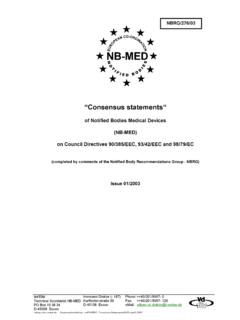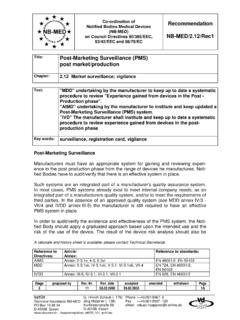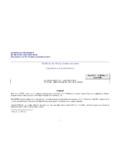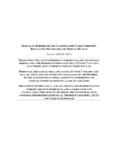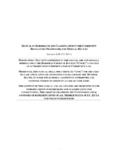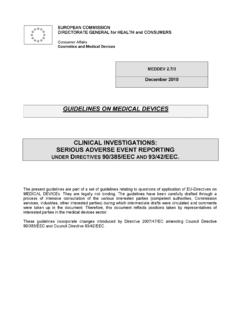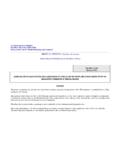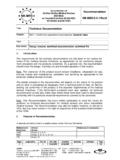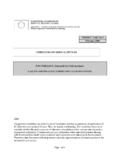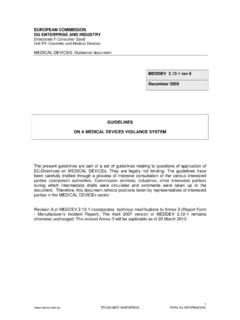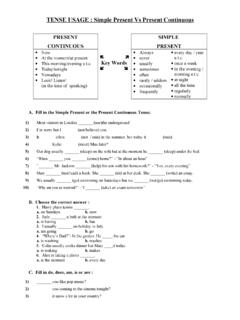Transcription of MEDICAL DEVICES: Guidance document
1 EUROPEAN COMMISSION. DG ENTERPRISE. Directorate G. Unit 4 - Pressure Equipment, MEDICAL devices , Metrology MEDICAL devices : Guidance document MEDDEV July 2001. GUIDELINES FOR THE CLASSIFICATION. OF MEDICAL devices . The present Guidelines are part of a set of Guidelines relating to questions of application of EC- Directives on MEDICAL devices . They are legally not binding. The Guidelines have been carefully drafted through a process of intensive consultation of the various interested parties (competent authorities, Commission services, industries, other interested parties) during which intermediate drafts were circulated and comments were taken up in the document . Therefore, this document reflects positions taken by representatives of interested parties in the MEDICAL devices sector. Note : This document is a revision of an earlier document published in December 1999 as MEDDEV. rev. 6. -1- Pages 1. PURPOSE AND PHILOSOPHY OF MEDICAL DEVICE.
2 CLASSIFICATION .. 3. 2. PRACTICAL RELEVANCE OF General requirements.. Conformity assessment .. Clinical Labelling .. 3. HOW TO CARRY OUT CLASSIFICATION .. Basic definitions .. Application How to use the rules and the decision tree .. Practical example .. Handling of interpretational 4. EXPLANATIONS OF INDIVIDUAL RULES .. Graphical summary - Guidance chart .. General explanation of rules/Practical APPENDICES: 1. Annex IX of the MEDICAL Device Directive -2- 1. PURPOSE AND PHILOSOPHY OF MEDICAL DEVICE. CLASSIFICATION. It is not feasible economically nor justifiable in practice to subject all MEDICAL devices to the most rigorous conformity assessment procedures available. A graduated system of control is more appropriate. In such a system, the level of control corresponds to the level of potential hazard inherent in the type of device concerned. A MEDICAL device classification system is therefore needed, in order to channel MEDICAL devices into the proper conformity assessment route.
3 In order to ensure that conformity assessment under the MEDICAL Device Directive functions effectively from January 1995, manufacturers should be able to know as early as possible in which class their product is. Identification of the class of each individual type of device by a committee procedure would have taken too long to achieve this goal. It was therefore decided to set up a system of classification rules within the directive, so that each manufacturer could classify its own devices . A simple set of classification rules based on technical features of MEDICAL devices existing now and in the future is impossible, because of the vast number and the changing nature of variables involved. The human body, however, is a relatively unchanging element of the equation. The European legislator established therefore a classification concept which is essentially based on potential hazards related to the use and possible failure of devices taking account of technology used and of health policy considerations.
4 This approach in turn allows the use of a small set of criteria that can be combined in various ways: duration of contact with the body, degree of invasiveness and local vs. systemic effect. It is recognized that although the existing rules will adequately classify the vast majority of existing devices , a small number of difficult cases may arise. Such cases may in particular include the determination of the borderline between two classes. In addition there may be devices that cannot be classified by the existing rules because of their unusual nature or situations where the classification would result in the wrong level of conformity assessment in light of the hazard represented by the device. -3- 2. PRACTICAL RELEVANCE OF CLASSIFICATION. General requirements All devices must: - meet the essential requirements irrespective of the class of the device (see also Annex VIII of the Directive). - be subject to the reporting requirements under the MEDICAL device vigilance system.
5 - be CE marked (except custom-made devices and devices intended for clinical investigation). Note: If Annex VIII applies (custom made devices and devices intended for clinical investigation) then all its requirements apply irrespective of the class of the device. Class I custom made devices need not be accompanied by the statement referred to in Annex VIII (Art. 4). Conformity Assessment CONFORMITY CLASSES. ASSESSMENT. PROCEDURES. ANNEXES I I I II A II B III. sterile meas. II (+ ) . II (- Sect. 4) . III . IV . V . VI . VII . -4- Clinical data Clinical evaluation The MEDICAL devices Directive states that as a general rule, confirmation of conformity with the requirements concerning the characteristics and performances referred to in sections 1 and 3 of Annex I of Directive 93/42/EEC under the normal conditions of use of the device and the evaluation of the undesirable side-effects must be based on clinical data.
6 This rule applies in particular in the case of implantable devices and devices in class III (Annex X, section ). Clinical investigation Clinical investigation with Class III devices and implantable and long-term invasive devices falling within Class II A or II B may start 60 days after their notification to the Competent Authority unless a negative decision from the Competent Authority has been received within this timeframe. (Art. 15). Instructions for use Instructions for use are not required for Class I and II A devices if these devices can be used safely without such instructions (Annex I Sect. ). Miscellaneous The manufacturer, or persons responsible for marketing of a Class I. product and designated by the manufacturer, must notify their address and the devices concerned to the Competent Authority of the Member State where they have their registered place of business (Art. 14). 3. HOW TO CARRY OUT CLASSIFICATION.
7 The manufacturer should first decide if the product concerned is a MEDICAL device as defined in the Directive 93/42 or an accessory to such a MEDICAL device and if it therefore comes within the scope of this Directive. Active implantable devices and devices for in vitro diagnosis are covered by separate directives, which do not apply the classification rules reviewed in these Guidelines. -5- Basic definitions The classification rules are based on terms related to duration of contact with the patient, degree of invasiveness and the part of the body affected by the use of the device. These terms are defined in Section I of Annex IX. of the Directive and reproduced below, together with some additional Guidance . Time Duration Transient Normally intended for continuous use for less than 60 minutes. Short term Normally intended for continuous use for not more than 30 days. Long term Normally intended for continuous use for more than 30 days.
8 Concept of continuous use Concepts of duration such as transient, short term and long term are defined in terms of continuous use. Continuous use must be understood as an uninterrupted actual use for the intended purpose. For instance, a scalpel may be used on the same patient throughout an operation that may last for several hours. The uninterrupted use for an intended purpose, cutting tissue, will normally not last for more than a few seconds at a time. Therefore a scalpel is a transient use device. However where usage of a device is discontinued in order for the device to be replaced immediately by the same or an identical device ( replacement of a ureteric catheter) this shall be considered an extension of the continuous use of the device. Invasiveness Invasive devices -6- A device which, in whole or in part, penetrates inside the body, either through a body orifice or through the surface of the body.
9 Body orifice Any natural opening in the body, as well as the external surface of the eyeball, or any permanent artificial opening, such as a stoma. Surgically invasive device An invasive device which penetrates inside the body through the surface of the body, with the aid or in the context of a surgical operation. For the purposes of this Directive devices other than those referred to in the previous subparagraph and which produce penetration other than through an established body orifice, shall be treated as surgically invasive devices . There are two exceptions to this: A surgically created stoma used in colostomy and ileostomy or permanent tracheostomy is considered to be a natural body orifice. Therefore devices introduced into such a stoma are not surgically invasive. A surgically created opening to allow access to the circulatory system in contrast should not be considered to be such a "natural body orifice".
10 devices introduced into such an opening are surgically invasive. A device that administers energy to the body should not be considered as invasive if only energy penetrates the body and not the device itself. Energy as such is not a device and therefore it cannot be classified. Only the device generating the energy must be classified. However, if a device administers a substance, whether this substance is a medicine or a MEDICAL device, such a substance must be assessed in its own right ( substances administered by a jet injector). Any device which, in whole or in part, penetrates inside the body, either through a natural body orifice or through the surface of the body is an invasive device. A surgically invasive device always implies that it enters through an artificially created opening. This can be a large opening, such as a surgical incision, or it can be a pinprick opening created by a needle. Therefore surgical gloves and needles used with syringes are surgically invasive.
